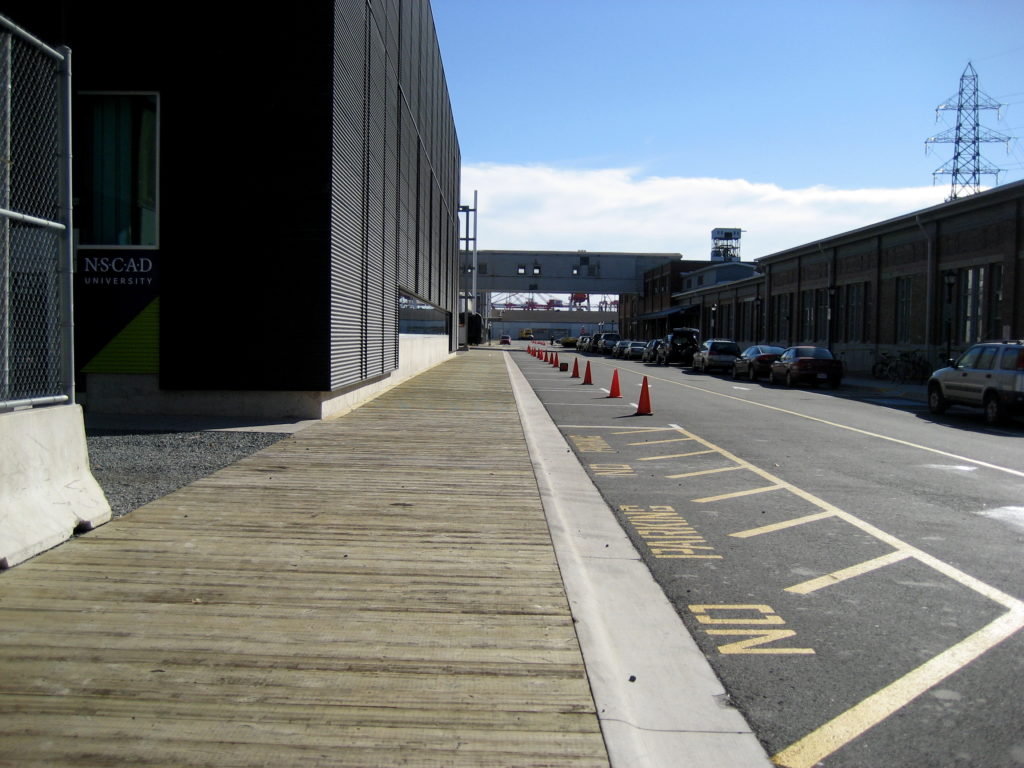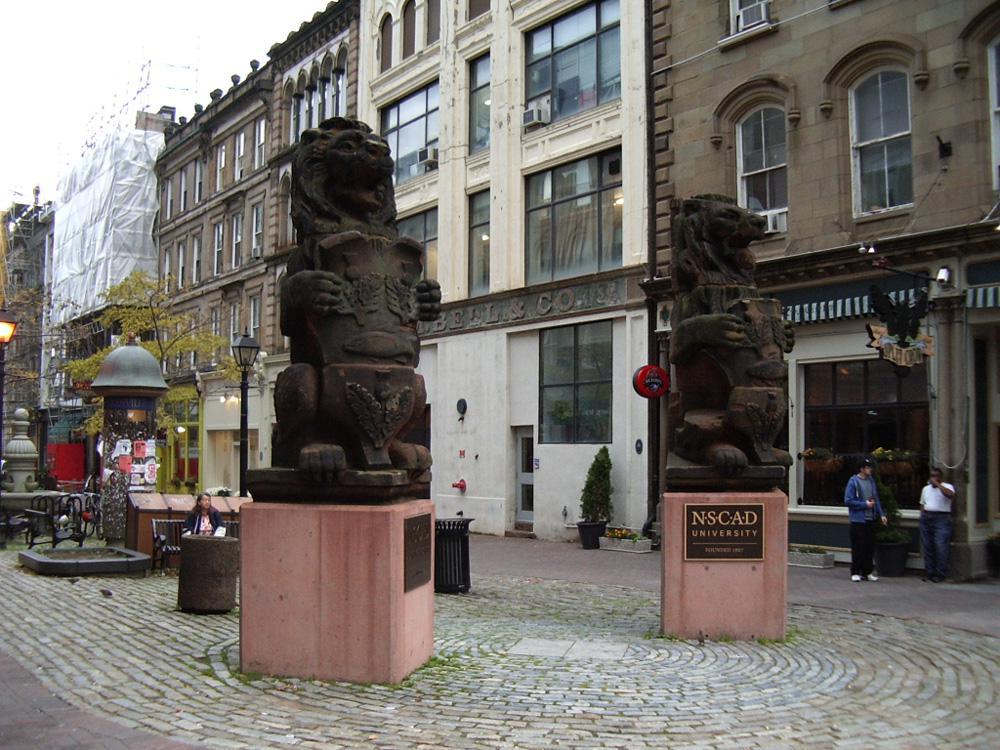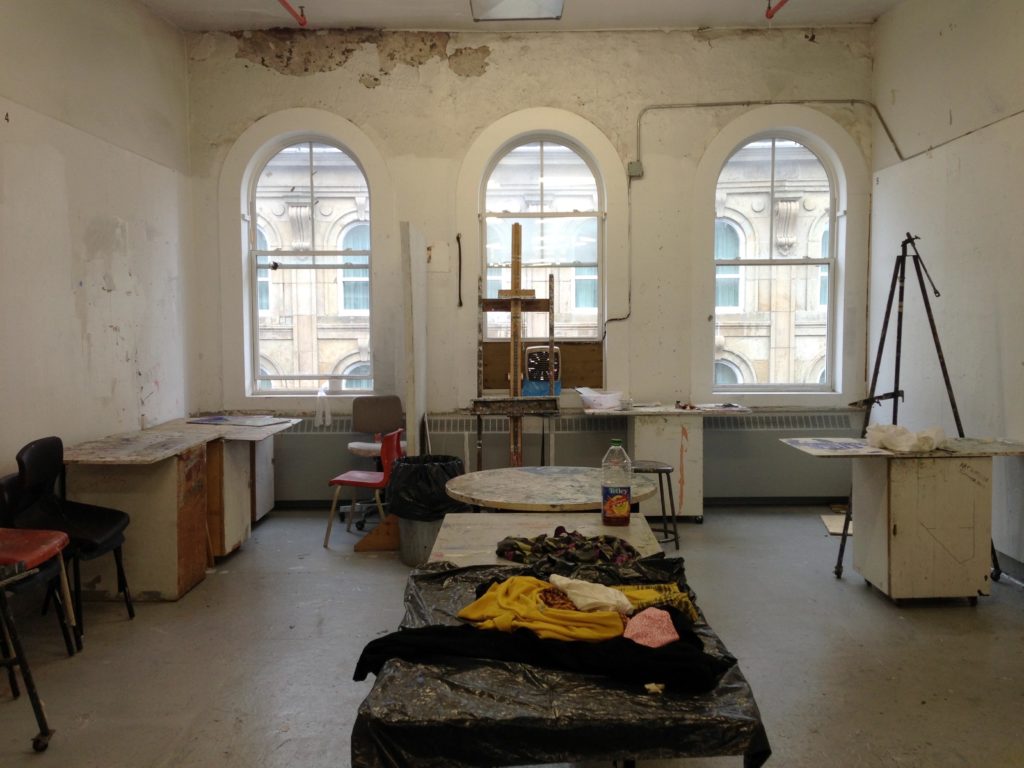It is no secret that NSCAD University is in trouble. Since the early 2000s, the school has been plagued with scandals, merger threats, skyrocketing tuition, financial woes, mass layoffs and faculty strikes. In the last decade, the Nova Scotia government—whose otherwise stagnant approach to post-secondary education is notable—provided a $10.2 million bailout after the federal government dropped out from contributing funds to the construction of the Port Campus in 2007, which NSCAD is due to lease until 2045. The government also placed NSCAD on notice to stabilize its enrolment, and told the institution to get its financial management under control, conditions that NSCAD had little choice but to oblige. And while NSCAD’s leadership has attempted to secure a bright financial future, such efforts have often been to the detriment of the institution’s primary stakeholders: students, faculty and the broader arts community.
Just over a month ago, we saw, in my opinion, the biggest NSCAD blunder of this new decade: the removal of Dr. Aoife Mac Namara as president. This removal on June 26 compromised good faith in the university’s anti-racism efforts, and it severely damaged community, student and faculty trust in the board.
What has happened in the month since has made me reflect on a book about NSCAD released a few years ago, former president Garry Neill Kennedy’s The Last Art College. Sometimes I wonder if what we are seeing now is the last of that lastness—I wonder what credible future there is for this institution at all, at least without major changes to its board structure. And I wonder what the scenario for such changes could possibly be given that the Nova Scotia government, on July 28, itself quashed a motion to re-examine university board appointments.
*
As an African Nova Scotian and L’nu educator, organizer and artist who attended NSCAD and faced anti-Black racism by administration and in the classroom, I have often spoken beyond just advocating on Black methodologies and contemporary cultural practice, focusing as well on how Euro-Canadians in critical positions of institutional power can step up and champion intersectionality. This is a challenging proposition, but it that was one executed by Mac Namara, who I feel made sincere connections to my community while also reflecting through her own Irish background as a racialized and oppressed people in past centuries. At NSCAD, it seemed like Mac Namara had done what no other recent president had managed to do: earn the respect and support of faculty, students and the NSCAD community, despite having been on the job for less than a year.
On June 5, just weeks before her dismissal, Mac Namara released a statement calling for a formal process of institutional healing, reconciliation and decolonization; a thorough review on institutional racism stretching the entirety of NSCAD’s history; and a multi-stakeholder task force to create an official anti-racism action plan (PADCARI: Presidential Advisory Council on Anti-Racist Initiatives).
This is just one initiative or outreach of Mac Namara’s that has made a significant impression in a brief period of time at the school—a school five minutes’ walk from North End, but antagonistic or inaccessible to long-oppressed Black and Indigenous peoples in the region.
DeRico Symonds, a prominent African Nova Scotian organizer involved with Game Changers 902, a Black youth organizing collective, had until recently been in collaboration with Mac Namara in making NSCAD’s Bell Auditorium accessible to the Black community for story sharing, and making equipment such as microphones and speakers available for Black public-school students affected by COVID-19.
“What a mistake. Progressive, and truly wanting to make a difference. This is the only time I can remember that the president of anything reached out to me and asked how they can learn about what’s happening in the black community and how she can help,” Symonds tweeted on June 29, in response to the news of Mac Namara’s dismissal. He also spoke with CBC News: “I thought it was amazing and pretty progressive of a university president to reach out and actively wanting to know those things,” he stated. “I was disappointed to see that she was let go.”
“Dear @NSCADUniversity, I’m saddened,” tweeted Kathryn R. Burton, a Mi’kmaw woman and chief of staff for Boston Mayor Martin J. Walsh, on June 28. “President @aoife_macnamara is one of Canada’s finest University Presidents. She treated my dying brother with the ultimate respect & understood diversity = institutional strength. That strength created better artists.”
“[Mac Namara] is definitely one of the best allies that the Mi’kmaq have and I feel she has been silenced partly because of that,” We’koqma’q First Nation’s Keptin of the Mi’kmaq Grand Council, Phillip Prosper, tweeted in response to Burton. “I’m sorry if I’m wrong but I’m tweeting emotionally right now. I hope you land on your feet @aoife_macnamara.”
“A lot of us were extremely shocked by it, it was an absurd decision and it certainly came out of nowhere,” Wren Tian-Morris, a recent graduate and former head of NSCAD’s Queer Collective, told Global News on June 29. “[Mac Namara] was trying to be productive and listen to these calls to action on how to change the institution and it just seemed like it was going well in all regards.”
Indigenous instructor and artist Carrie Allison, another NSCAD graduate, wrote an open letter to the then–acting president Ann-Barbara Graff on June 29 stating that she was refusing to teach her courses scheduled to begin on July 2 until systemic racism at NSCAD was addressed.
“As one of the few courses that is directly addressing oppression, structural racism, white supremacy within the art world, Exhibiting Indigenous Art has been designed to look at the systemic structures that hinder and immobilize Indigenous sovereignty in museums, galleries, artist run centres, and, by extension, education,” Allison wrote. “It also highlights the incredible work that Indigenous artists, curators, and arts professionals have done to change these structures, although still we do not have a seat at the table. How can I teach a course on these topics within an institution that upholds the very systems I would have been asking my students to recognize, critique, and imagine dismantling.”
 A view of the NSCAD Port Campus. Photo: Chris Campbell via Flickr. CC BY-NC 2.0.
A view of the NSCAD Port Campus. Photo: Chris Campbell via Flickr. CC BY-NC 2.0.
In the weeks since those first responses to Mac Namara’s dismissal emerged, a petition signed by more than 4,800 people has called for her reinstatement, and for the board to be fired. Faculty chairs wrote an open letter to the board, while faculty unions at NSCAD, OCAD and Vancouver Island University made public statements in support of her, and NSCAD’s new Canada Research Chair, Charmaine Nelson, wrote a letter of concern about the dismissal being an “attack”on anti-racism efforts. Most recently, on a day of action July 21, concerned community members mobilized in contacting members of the board and provincial government, calling for greater transparency.
But transparency on this or other fronts from the board remains sorely lacking.
In an internal memo to the NSCAD community on June 28, the NSCAD Board of Governors indicated that Mac Namara’s removal was a “personnel matter.” CBC reported that board of governors chair Louise-Anne Comeau would not comment further on Mac Namara’s departure for reasons of confidentiality, and thus provided no rationale that would justify its decision.
There is speculation, and ongoing media investigation, however, first reported on by Tim Bousquet in the Halifax Examiner, as to why NSCAD’s Board of Governors removed the widely respected Mac Namara as president: namely, a conflict over local real estate worth many millions of dollars.
“In the 1970s, the university moved from Coburg Road to downtown by purchasing the eastern half of the Granville Street portion of the Historic Properties developed by Ben McCrea, owner of the Armour Group,” Bousquet writes. “That sale included a provision that should the university ever sell the property, Armour Group would have first rights of refusal.”
Bousquet continues: “Fast forward to the present day. Ben McCrea died some years ago, and Armour is now controlled by his son, Scott McCrea…. In addition to the Historic Properties, the Armour Group owns the Waterside, Founders Square, and the dog-awful Queen’s Marque project now blighting the waterfront. And NSCAD’s Granville campus could join that real estate portfolio. McCrea has made some sort of offer to the university for the property…. As the adjacent Cogswell redevelopment project is about to commence, now might be an opportune time to unload the property to a developer.”
Bousquet goes on to state that Mac Namara was opposed to the sale because of alleged conflicts of interest on the board. The proposal by Armour Group Limited (AGL) would essentially purchase the property, a deal that would include constructing a new accessibility-compliant building for NSCAD to lease. Sean Kelly, vice-chair of the NSCAD Board of Governors, also happens to be a partner at Stewart McKelvey, the firm listed as a solicitor of record for AGL on an appeal in 2018. On March 6, 2020, Stewart McKelvey also released an announcement about relocating the firm’s Halifax office to the new Queen’s Marque, also owned by AGL.
While much of this discussion around potential conflict of interest is speculative, the board has remained publicly silent on issues raised by Bousquet and others—a move that, in the current context, seems to fuel further speculation. Where transparency is needed, even outside of Mac Namara’s dismissal, the board has offered none.
*
The Board of Governors—besides dismissing Mac Namara as president in the first place, stalling the anti-racism efforts she started and failing to provide transparency to show that her ousting is not some real-estate-fuelled decision—has also been responding poorly to the criticism it has received over the past month. To my mind, this lack of acuity in public response further erodes community confidence in the board and its decisions, past or future, no matter what PR firm they may hire.
Recently, I spoke with Robin Jensen, president of the Nova Scotia Art Educators Society, about a response she received regarding a personal letter she sent to the board: “I got a call from Dave van de Wetering, a member of the board [and currently the chair of NSCAD’s Audit and Risk Oversight Committee], after I sent a personal letter to state my dissent on the decision to remove Mac Namara. He was mostly ‘mansplaining’ to me about how NSCAD was moving in a fine direction, and how they even had a Black member on the board,” she alleged. “He didn’t call to talk it over, he called to defend the board’s decision as though the faculty and students just didn’t understand.”
Van de Wetering also responded to other letters—quite poorly. One shared to the Friends of NSCAD Facebook group by Lisa Morse, an NSCAD alum, reportedly stated: “Know that if you read the CVs of each and every Board Member, you would find a varied list of experience and they are not all from the corporate sector—there are and have been Artists, also Retirees—diversity is good for every organization,” van de Wetering wrote. “In closing, I am confident, that we both feel we are doing the best for NSCAD. For my part because I love the arts and education, have purchased lots of both, and was appointed after applying to the Government of Nova Scotia (who funds well over half of NSCAD each year), deemed my skills and commitment as useful and appropriate.”
Carrie Allison also writes in her open letter that, after receiving the memo June 26 about Mac Namara’s dismissal, “I tried responding to this shocking email by asking [board chair] Louise-Anne Comeau if she could elaborate. When I pressed ‘send’ I got a message back that said ‘The groups at nscad.ca only accept messages from people on their allowed senders list, and your address isn’t on the lists.’ Apparently I can’t even message the persons responsible for holding our community and university back. This is a clear indication of where hierarchies within the institution silence the voices of contract staff, and these positions are predominantly filled by marginalized communities.”
Entrenched in an environment of defensiveness and arrogance, these responses underline to me the board’s inability to make effective public-relations and internal communications decisions, among other failings.
 Part of the NSCAD campus at Granville and Duke Streets. Photo: Griva via Wikimedia.
Part of the NSCAD campus at Granville and Duke Streets. Photo: Griva via Wikimedia.
If the NSCAD Board of Governors is not serving the community well right now—according to many members of the community, and epitomized by the reaction to Mac Namara’s dismissal—then how might the board be improved?
One way might be to increase the proportion of artists, faculty and students on the board.
As is the case with many large arts organizations, NSCAD has a board made up of mainly senior executives and owners of various private companies, but very few artists. According to the NSCAD website at press time, there are currently 18 members (with a maximum of 23, according to the legislation governing the university) on the board, and 70 per cent of those seats are appointed either by the provincial government or, in the case of a resignation or death, by the board. The remaining 30 per cent of the voting power is split evenly between 6 seats reserved for representatives of the alumni association and student and faculty unions.
But one could make the case, budgetarily, for increasing the number of students on the board. According to NSCAD’s 2018–19 annual report, 42.8 per cent of NSCAD income came from the provincial government’s operating grant—a 5.7 per cent decrease from 2017–18. Moreover, revenue from student fees increased by 6.8 per cent, forming 39.1 per cent of NSCAD income, almost equal to with the provincial government’s base contribution. On top of that, NSCAD’s tuition fees have increased by nearly 50 per cent in the past five years.
It is no wonder students have been very resistant to NSCAD in the past 10 years; not only are they investing in their education, they are also investing in the institution, while holding only 9 per cent (i.e., two representative seats on the Board of Governors) of decision-making influence.
Notably, the NSCAD student union released a call to action via Instagram on June 24, a few days prior to Mac Namara’s dismissal. The union statement demands that the Board of Governors change its structure to comprise “at least 1/3 BIPOC identifying members,” with “1/4 of members being creatives or having direct ties to the Arts community.”
The NSCAD Board of Governors posted a response the next day: “From the perspective of NSCAD’s Board of Governors, we continue our strong condemnation of all forms of discrimination and systemic racism, and want to reiterate our commitment to the further diversification of our membership by ensuring representation from the BIPOC community.”
This statement is in tension with the fact that on June 7, Comeau asked Mac Namara to “put forward the claims” of systemic racism through a risk-assessment presentation, which she delivered the day before her firing.
It seems that while Comeau was interested in and concerned about the risks associated with an institution taking—or not taking—racism seriously, the spectacle and removal of Mac Namara (during a global health crisis, no less) only serves to increase the risk of low student retention and, in turn, the potential loss of essential tuition revenue.
Again, perhaps it is board leadership reform, rather than executive leadership reform, that was and is needed here.
*
The callous decision by the NSCAD Board of Governors to remove Mac Namara during her implementation of reforms may ultimately end up creating more headaches than the board intended—in fact, it already has.
Unlike the Board of Governors, is currently made up of at least 80 per cent white members, Mac Namara is a key example of what white allyship looks like in modern-day institutions: not perfect, but evolutionary, receptive, decisive and inclusive. This is not praise I give lightly.
We may never know the true motivations behind this move by the board—but they are being closely watched. With a pandemic underway, students are no longer stuck in 24-hour studios finishing assignments; they now have the agency to witness the board in real time.
“Our NSCAD community knows where we’ve come from and celebrates this history, but we’re not looking backwards,” said then-president Diane Taylor-Gearing in early 2016 regarding the Art Gallery of Nova Scotia’s survey exhibition “The Last Art College: Nova Scotia College of Art and Design, 1968–1978” (a show related to the book of the same title). “Recent challenges are behind us and we wear our mantle of independence fiercely and without taking it for granted,” she continued. “We are and will always be a home for the rule breakers, the dreamers, the makers, the innovators, the exceptional, the forever curious.”
While Taylor-Gearing encouraged one of the biggest tuition increases in NSCAD’s history during her tenure, on the points above, she is correct. NSCAD must follow the dream of looking into the future of what a public art institution means, especially if it is to remain relevant in the 21st century. NSCAD is a one-of-a-kind institution in Nova Scotia, and in Canada for that matter, and it must remain independent, well-funded and artist-run. It must embrace the historical diversity of art practices and histories in the Atlantic region.
In writing this article, I asked Mac Namara to comment on the entirety of what has unfolded; however, she declined to be interviewed. Based on the response of the community, the best option NSCAD has right now, in my opinion, is to reinstate Mac Namara so that she may continue to rebuild the school’s active participation not only with BIPOC stakeholders and communities, but also with students, faculty and Nova Scotians at large. The provincial government should increase public funding to post-secondary institutions; it needs to look at new ways to hold public institutions accountable; it needs to review the process for university board appointments; and it must implement more efficient oversight. After all, this is the Nova Scotia College of Art and Design. It belongs to all Nova Scotians—not just to the privileged, private-sector interests that continue, before and after June 26, to make up the majority of its board.

 View of a NSCAD University painting studio at end of term in 2013. Photo: Leah Sandals.
View of a NSCAD University painting studio at end of term in 2013. Photo: Leah Sandals.






